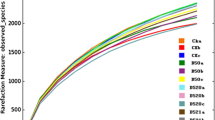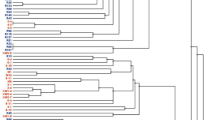Abstract
High-throughput sequencing of the amplicon gene library revealed variations in the population structure of clover rhizobia (Rhizobium leguminosarum bv. trifolii) upon transition from soil into the root nodules of the host plant (Trifolium hybridum). Analysis of rhizobial diversity using the nodA gene revealed 3258 and 1449 nucleotide sequences (allelic variants) for the soil and root nodule population, respectively. They were combined into 29 operational taxonomic units (OTU) according to the 97% identity level; 24 OTU were found in the soil population, 12 were present in the root nodule population, and 7 were common. The predominant OTE13 (77.4 and 91.5% of the soil and root nodule populations, respectively) contained 155 and 200 variants of the soil and root nodule populations, respectively, with the nucleotide diversity increasing significantly upon the “soil → root” transition. The “moving window” approach was used to reveal the sites of the nodA gene in which polymorphism, including that associated with increased frequency of non-synonymous substitution frequency, increased sharply upon transition from soil into root nodules. PCR analysis of the IGS genotypes of individual strains revealed insignificant changes in rhizobial diversity upon transition from soil into root nodules. These results indicate that acceleration of rhizobial evolution in the course of symbiosis may be associated with development of highly polymorphic virulent subpopulations subjected to directional selection in the “plant-soil” system.
Similar content being viewed by others
References
Provorov, N.A. and Vorob’ev, N.I., Geneticheskie osnovy evolyutsii rastitel’no-mikrobnogo simbioza (Genetic Foundations of the Evolution of Plant-Microbial Symbiosis), Tikhonovich, I.A., Ed., St.-Petersburg: Inform-Navigator, 2012.
Andronov, E.E., Terefework, Z., Roumiantseva, M.L., Dzyubenko, N.I., Onichtchouk, O.P., Kurchak, O.N., Dresler-Nurmi, A., Young, J.P.W., Simarov, B.V., and Lindström, K., Symbiotic and genetic diversity of Rhizobium galegae isolates collected from the Galega orientalis gene center in the Caucasus, Appl. Environ. Microbiol., 2003, vol. 69, pp. 1067–1074.
Hirsch, P.R., Population dynamics of indigenous and genetically modified rhizobia in the field, New Phytol., 1996, vol. 133, pp. 159–171.
Andrade, D.S., Murphy, P.J., and Giller, K.E., The diversity of Phaseolus-nodulating rhizobial populations is altered by liming of acid soils planted with Phaseolus vulgaris L. in Brazil, Appl. Environ. Microbiol., 2002, vol. 68, pp. 4025–4034.
Carelli, M., Gnocchi, S., Fancelli, S., Mengoni, A., Paffetti, D., Scotti, C., and Bazzicalupo, M., Genetic diversity and dynamics of Sinorhizobium meliloti populations nodulating different alfalfa cultivars in Italian soils, Appl. Environ. Microbiol., 2000, vol. 66, pp. 4785–4789.
Wilkinson, H.H., Spoeke, J.M., and Parker, M.A., Divergence in symbiotic compatibility in a legumeBradyrhizobium mutualism, Evolution, 1996, vol. 50, pp. 1470–1477.
Kosier, B., Pühler, A., and Simon, R., Monitoring and diversity of Rhizobium meliloti field and microcosm isolates with a novel rapid genotyping method using insertion elements, Molec. Ecol., 1993, vol. 2, pp. 35–46.
Minamisawa, K., Nakatsuka, Y., and Isawa, T., Diversity and field site variation of indigenous populations of soybean bradyrhizobia in Japan by fingerprints with repeated sequences RSα and Rsβ, FEMS Microbiol. Ecol., 1999, vol. 29, pp. 171–178.
Ferreira, M.C., Andrade, D.S., Chueire, L.M., Takemura, S.M., and Hungria, M., Tillage method and crop rotation effects on the population sizes and diversity of bradyrhizobia nodulating soybean, Soil Biol. Biochem., 2000, vol. 32, pp. 627–637.
Krasil’nikov, N.A., Variability of root nodule bacteria, Dokl. Akad. Nauk SSSR, 1941, vol. 31, pp. 90–92.
Roumyantseva, M.L., Andronov, E.E., Sagulenko, V.V., Onishchuk, O.P., Provorov, N.A., and Simarov, B.V., Instability of cryptic plasmids in strain Sinorhizobium meliloti P108 in the course of symbiosis with alfalfa Medicago sativa, Rus. J. Genet. 2004, vol. 40, no. 4, pp. 356–362.
Weaver, R.W. and Wright, S.F., Variability in effectiveness of rhizobia during culture and in nodules, Appl. Environ. Microbiol., 1987, vol. 53, pp. 2972–2974.
Broughton, W.J., Samrey, U., and Stanley, J., Ecological genetics of Rhizobium meliloti: symbiotic plasmid transfer in the Medicago sativa rhizosphere, FEMS Microbiol. Lett., 1987, vol. 40, pp. 251–255.
Pretorius-Güth, I.M., Pühler, A., and Simon, R., Conjugal transfer of megaplasmid 2 between Rhizobium meliloti strains in alfalfa nodules, Appl. Environ. Microbiol., 1990, vol. 56, pp. 2354–2359.
Chernova, T.A., Aronshtam, A.A., and Simarov, B.V., Genetic nature of Rhizobiul meliloti nonvirulent mutants CXM1-125 and CXM1-126, Genetika, 1986, vol. 22, pp. 2066–2073.
Maynard Smith, J., Feil, E.J., and Smith, N.H., Population structure and evolutionary dynamics of pathogenic bacteria, BioEssays, 2000, vol. 22, pp. 1115–1122.
Rumyantseva, M.L., Simarov, B.V., Onishchuk, O.P., Andronov, E.E., Chizhevskaya, E.P., Belova, V.S., Kurchak, O.N., Muntyan, A.N., Rumyantseva, T.B., and Zatovskaya, T.V., Biologicheskoe raznoobrazie kluben’kovykh bakterii v ekosistemakh i agrotsenozakh. Teoreticheskie osnovy i metody (Biodiversity of Root Nodule Bacteria in Ecosystems and Agrocenoses), St. Petersburg: VNIISKhM, 2011.
Malferrati, G., Monferinin, P., and De Blasio, P., High-quality genomic DNA from human whole blood and mononuclear cells, Bio Techniques, 2002, vol. 33, pp. 1228–1230.
Laguerre, G., Mavingui, P., Allard, M.R., Charnay, M.P., Lauvrier, P., Mazurier, S.I., Rigottier-Gois, L., and Amarger, N., Typing of rhizobia by PCR DNA fingerprinting and PCR-restriction lengths polymorphism analysis of chromosomal and symbiotic gene regions: application to Rhizobium leguminosarum and its different biovars, Appl. Environ. Microbiol., 1996, vol. 62, pp. 2029–2036.
Caporaso, J.G., Kuczynski, J., Stombaugh, J., Bittinger, K., Bushman, F.D., Costello, E.K., Fierer, N., Pen~a, A.G., Goodrich, J.K., Gordon, J.I., Huttley, G.A., Kelley, S.T., Knights, D., Koenig, J.E., Ley, R.E., Lozupone, C.A., McDonald, D., Muegge, B.D., Pirrung, M., Reeder, J., Sevinsky, J.R., Turnbaugh, P.J., Walters, W.A., Widmann, J., Yatsunenko, T., Zaneveld, J., and Knight, R., QIIME allows analysis of high throughput community sequencing data, Nature Methods, 2010, vol. 7, pp. 335–336.
Tamura, K., Peterson, D., Peterson, N., Stecher, G., Nei, M., and Kumar, S., MEGA5: Molecular Evolutionary Genetics Analysis using maximum likelihood, evolutionary distance and maximum parsimony method, Molec. Biol. Evol., 2011, vol. 28, pp. 2731–2739.
Rozas, J., Sánchez-Delbarrio, J.C., Messeguer, X., and Rozas, R., DnaSP, DNA polymorphism analyses by the coalescent and other methods, Bioinformatics, 2003, vol. 19, pp. 2496–2497.
Nei, M., Estimation of average heterozygosity and genetic distance from a small number of individuals, Genetics, 1978, vol. 89, pp. 583–590.
Selander, R.K., Caugant, D.A., Ochman, H., Musser, J.M., Gilmour, M.N., and Whittam, T.S., Methods of multilocus enzyme electrophoresis for bacterial population genetics and systematics, Appl. Environ. Microbiol., 1986, vol. 51, pp. 873–884.
Wittebolle, L., Marzorati, M., Clement, L., Balloi, A., Daffonchio, D., Heylen, K., De Vos, P., Verstraete, W., and Boon, N., Initial community evenness favors functionality under selective stress, Nature, 2009, vol. 458, pp. 623–626.
Tikhonovich, I.A. and Provorov, N.A., Simbiozy rastenii i mikroorganizmov: molekulyarnaya genetika agrosistem budushchego (Plant-Microbial Symbioses: Molecular Genetics of Future Agrosystems), St. Petersburg: Izd-vo SPbGU, 2009.
Hirsch, A.M., Lum, M.R., and Downie, J.A., What makes the rhizobia-legume symbiosis so special? Plant Physiol., 2001, vol. 127, pp. 1484–1492.
Author information
Authors and Affiliations
Corresponding author
Additional information
Original Russian Text © E.E. Andronov, O.P. Onishchuk, O.N. Kurchak, N.A. Provorov, 2014, published in Mikrobiologiya, 2014, Vol. 83, No. 4, pp. 500–508.
Rights and permissions
About this article
Cite this article
Andronov, E.E., Onishchuk, O.P., Kurchak, O.N. et al. Population structure of the clover rhizobia Rhizobium leguminosarum bv. trifolii upon transition from soil into the nodular niche. Microbiology 83, 422–429 (2014). https://doi.org/10.1134/S0026261714030035
Received:
Published:
Issue Date:
DOI: https://doi.org/10.1134/S0026261714030035




